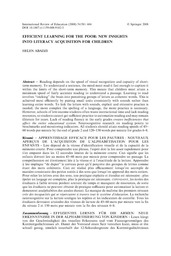
ATTENTION: The works hosted here are being migrated to a new repository that will consolidate resources, improve discoverability, and better show UTA's research impact on the global community. We will update authors as the migration progresses. Please see MavMatrix for more information.
Show simple item record
| dc.contributor.author | Abadzi, Helen | |
| dc.date.accessioned | 2014-07-03T19:51:31Z | |
| dc.date.available | 2014-07-03T19:51:31Z | |
| dc.date.issued | 2008 | |
| dc.identifier.citation | Published in the International Review of Education 54:581-604, 2008. | en_US |
| dc.identifier.uri | http://hdl.handle.net/10106/24336 | |
| dc.description.abstract | Reading depends on the speed of visual recognition and capacity of short-term memory. To understand a sentence, the mind must read it fast enough to capture it within the limits of the short-term memory. This means that children must attain a minimum speed of fairly accurate reading to understand a passage. Learning to read involves “tricking” the brain into perceiving groups of letters as coherent words. This is
achieved most efficiently by pairing small units consistently with sounds rather than learning entire words. To link the letters with sounds, explicit and extensive practice is needed; the more complex the spelling of a language, the more practice is necessary. However, schools of low-income students often waste instructional time and lack reading resources, so students cannot get sufficient practice to automatize reading and may remain illiterate for years. Lack of reading fluency in the early grades creates inefficiencies that affect the entire educational system. Neurocognitive research on reading points to benchmarks and monitoring indicators. All students should attain reading speeds of 45–
60 words per minute by the end of grade 2 and 120–150 words per minute for grades 6–8. | en_US |
| dc.language.iso | en_US | en_US |
| dc.publisher | Springer | en_US |
| dc.subject | Reading -- Primary Grade School | en_US |
| dc.subject | Education for All (EFA) | en_US |
| dc.subject | Reading Fluency | en_US |
| dc.title | Efficient Learning For the Poor: New insights Into Literacy Acquisition for Children | en_US |
| dc.type | Article | en_US |
| dc.publisher.department | Department of Curriculum and Instruction, The University of Texas at Arlington | en_US |
| dc.identifier.doi | http://dx.doi.org/10.1007/s11159-008-9102-3 | |
Files in this item
- Name:
- efficient learning for the poor ...
- Size:
- 896.9Kb
- Format:
- PDF
- Description:
- PDF
This item appears in the following Collection(s)
Show simple item record


